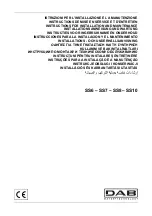
ENGLISH
23
11. TROUBLESHOOTING
Error conditions
FAULTS
CHECKS
(possible causes)
REMEDIES
1.
The pumps gives no water.
A. Water level in the well lower than
pump suction nozzle.
B. Blocked valve.
C. Leaks in the delivery pipe.
D. Voltage lower than the rated value
and absorption higher than normal.
E. Absorbed current lower than normal
due to air in the pump.
F. Clogged grid because of suspended
solids.
G. Unexpected fiction losses
A. Increase the pump depth.
B. Kick the pipe line with a hammer
trying to unblock the valve.
C. Check delivery pipe by the flanges.
D. Increase voltage.
Change the supply cable with a
larger one.
E. Start and stop the pump at intervals
of about a minute.
F. Clean the pump.
G. Check calculations and use larger
pipes if necessary.
2.
The pump is not starting but
fuses don’t blow up and
starter relays do not trip.
A. No voltage in the line.
B. The circuits is cut off by the cable on
in motor windin.
C. Open circuit in the starter.
A. Check voltage ratings on main and
on starter terminals.
B. Remove starter fuses and connect
one Ohmmeter conductor to delivery
pipe; Check then motor cables
terminals one by one with the other
conductor. The reading of each
terminal shloud be at least 10
Megahoms.
C. Check circuit integry referring to
electric diagrams.
3.
The starter trips or the fuses
blow-out when the pump is
running.
A. Too low voltage.
B. Overload due to sand clogging;
bearings tend to saize.
C. Single phase: a voltage 1.5/2 times
higher than normal runs through
motor windings, so the starter trips
stopping the unit.
D. The starter is installed in a too warm
place.
E. The
starter
in
not
correctly
calibrated.
F. Electropump blocked in a crooked
sinkhole with consequent abnormal
value of the absorbed current.
G. Cut-off conductors in the starter.
H. Grounded, short-circuited or cut-off
cable joint or motor windings.
A. Increase supply cable diameter.
B. Pull on the pump and clean it.
C. Check voltage on all three phases.
Check the conditions of starter fuses
and contact.
D. Set starter overload relays on the
highest value.
E. If the amperometer shows normal
voltage and the starter trips also
after different calibrations, replace
the overload relay.
F. Move the unit so to straighten it and
it again.
G. See point 2.C
H. See point 2.B
4.
The pump runs with a low
capacity or head.
A. Wrong motor rotation.
B. The delivery pipe leaks; flange or
coupling not well fastened.
C. Voltage
lower
than
normal,
absorbed
current
higher
than
normal.
D. Clogged grid.
E. Worm impellers and diffusers.
F. The manometric head has been
wrongly calculated.
A. Lift the pump out of the well and
check the delivery pipe.
B. Move the unit so to straighten it and
start it again.
C. Lift the pump out of the well and
check the delivery pipe.
D. Clean the pump.
E. Replace worm parts.
F. Calculate again the manometric
head; replace the unit with a more
suited one.



























